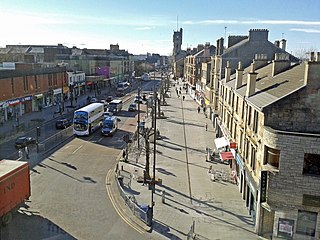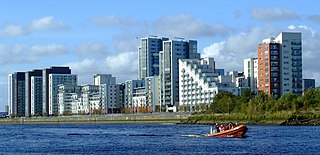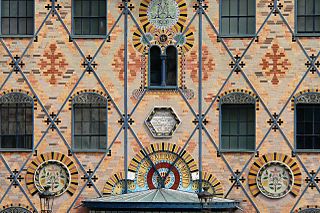
Rutherglen is a town in South Lanarkshire, Scotland, immediately south-east of the city of Glasgow, three miles from its centre and directly south of the River Clyde. Having previously existed as a separate Lanarkshire burgh, in 1975 Rutherglen lost its own local council and administratively became a component of the City of Glasgow District within the Strathclyde region. In 1996 the towns were reallocated to the South Lanarkshire council area.

Kilmarnock is a town and former burgh in East Ayrshire situated in southwest Scotland. The town has served as the administrative centre of East Ayrshire Council since 1996 and is the regions main commercial and industrial centre.
The year 1892 in architecture involved some significant events.

Glasgow Green is a park in the east end of Glasgow, Scotland, on the north bank of the River Clyde. Established in the 15th century, it is the oldest park in the city. It connects to the south via the St Andrew's Suspension Bridge.

Bridgeton is a district to the east of Glasgow city centre. Historically part of Lanarkshire, it is bounded by Glasgow Green to the west, Dalmarnock to the east and south, Calton to the north-west at Abercromby Street/London Road and Broad street to the north-east.

Glasgow Harbour in the following paragraphs is about a private sector urban regeneration scheme at Partick in the West End of the city of Glasgow, Scotland. It is not the history and development of the wider and internationally famous Glasgow Harbour from Glasgow Green to Clydebank which developed from the early 1800s and witnessed the birth and growth of modern shipbuilding and shipping.

The Glasgow Necropolis is a Victorian cemetery in Glasgow, Scotland. It is on a low but very prominent hill to the east of Glasgow Cathedral. Fifty thousand individuals have been buried here. Typical for the period, only a small percentage are named on monuments and not every grave has a stone. Approximately 3,500 monuments exist here.

Venetian Gothic is the particular form of Italian Gothic architecture typical of Venice, originating in local building requirements, with some influence from Byzantine architecture, and some from Islamic architecture, reflecting Venice's trading network. Very unusually for medieval architecture, the style is at its most characteristic in secular buildings, with the great majority of surviving examples of the style being secular.

Dean Clough in Halifax, Calderdale, West Yorkshire, England, is a group of large factory buildings built in the 1840s–60s for Crossley's Carpets, becoming one of the world's largest carpet factories. After years of declining production it closed in 1983, when it was bought by a consortium led by Sir Ernest Hall which developed the Grade II listed site for various commercial and cultural uses. It is now seen as a leading example of successful urban regeneration. Dean Clough is located on the north side of Halifax near the Victorian North Bridge and the modern flyover sections of the Burdock Way relief road system. The converted mills now house about 150 large and small businesses and arts venues including Crossley Gallery and several other art galleries and the Viaduct Theatre, home base for the Northern Broadsides theatre company. Phoenix Radio 96.7 FM has its studios in D Mill and Lloyds Banking Group has offices in G Mill.
James Templeton & Co was a Glasgow-based textile company that grew to become one of the leading carpet manufacturers in Britain during the 19th and 20th centuries.

The city of Glasgow, Scotland is particularly noted for its 19th-century Victorian architecture, and the early-20th-century "Glasgow Style", as developed by Charles Rennie Mackintosh.

West brewery is an alcoholic beverage restaurant located in the Templeton Building on Glasgow Green, Scotland. West produces German Style lagers and wheat beers, both in kegs and bottles, which are sold primarily to the UK market. All West lagers and wheat beers are brewed in accordance with the 1516 Reinheitsgebot, the ancient German Purity Law.

William Leiper FRIBA RSA (1839–1916) was a Scottish architect known particularly for his domestic architecture in and around the town of Helensburgh. In addition, he produced a small amount of fine ecclesiastical and commercial architecture in Glasgow and the Scottish Lowlands. He was also an accomplished watercolour artist, and from the late 1870s spent much spare time painting in oils and watercolours.

Blythswood Square is the Georgian square on Blythswood Hill in the heart of the City of Glasgow, Scotland. The square is part of the 'Magnificent New Town of Blythswood' built in the 1800s on the rising empty ground west of a very new Buchanan Street. These open grounds were part of the vast Lands of Blythswood stretching to the River Kelvin acquired by the Douglas-Campbell family in the 17th century. The Blythswood district, and its grid of streets, became a Conservation Area in 1970, because of its important architectural and historic buildings.

Polychrome brickwork is a style of architectural brickwork wherein bricks of different colours are used to create decorative patterns or highlight architectural features in the walls of a building. Historically it was used in the late Gothic period in Europe, and the Tudor period in England, and was revived in Britain in the 1850s as a feature of Gothic Revival architecture. Later in the 19th century and into the early 20th century it was adopted in various forms in Europe for all manner of buildings such as French eclectic villas, Dutch row houses, and German railway stations, and as far away as Melbourne, Australia, where the technique reached heights of popularity and elaboration in the 1880s.
Events from the year 1892 in Scotland.
Events from the year 1889 in Scotland.

Cottiers is a theatre located in Glasgow, Scotland. It also operates as a bar and restaurant. Cottiers occupies the building of the 19th-century former Dowanhill Parish Church.

British industrial architecture has been created, mainly from 1700 onwards, to house industries of many kinds in Britain, home of the Industrial Revolution in this period. Both the new industrial technologies and industrial architecture soon spread worldwide. As such, the architecture of surviving industrial buildings records part of the history of the modern world.

Arthur Francis Stoddard (1810–1882) was an American-born entrepreneur and philanthropist who founded Stoddard Carpets, Scotland's largest carpet company in the 19th century and a specialist in "tapestry carpets". The company later became Stoddard International.





















